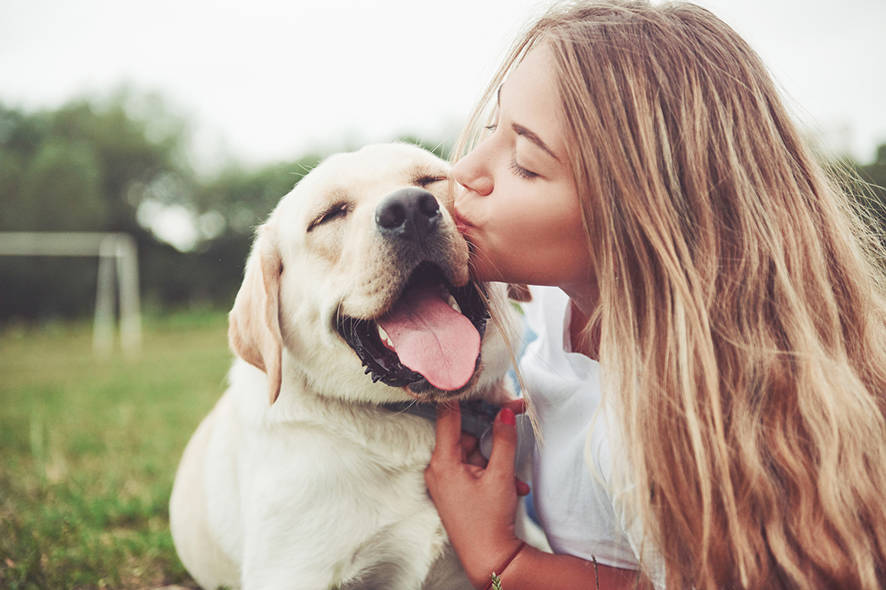Good oral health is just as important for dogs and cats as it is for the rest of your family. Your pets rely on their teeth to eat and defend themselves. Problems with teeth and gums don't just cause your pet pain and discomfort, but also puts them at risk of developing life-threatening health issues. You can help your dog or cat stay healthy by taking good care of their teeth and learning how to spot these common warning signs.
1. Bad breath
Okay, so we know pets don’t always have the best reputations for fresh breath. But if the odour isn't directly related to something they ate, it can sometimes indicate that bacteria and plaque have built up in their mouths. This puts their teeth at risk of decay.
If their breath smells particularly foul (like rotten eggs), this could be a sign that they have gum disease, which needs treatment from their vet. A study by the American Veterinary Dental Society found that 80 percent of dogs and 70 percent of cats have gum disease in some form by the age of three - the risk is higher for smaller dog breeds.1
Keep in mind there’s more at stake than just smelly breath. Untreated gum disease can damage your pet's teeth and jaws over time and is one of the major causes of tooth loss. Infections caused by gum disease have been linked with diseases of the heart, liver and kidneys, so you should talk to your vet if you notice any unusual odours.
2. Changes in eating habits
Any sudden change in your pet's appetite is a cause for concern, particularly when they don’t want to eat their regular food. Along with wider health concerns, symptoms of gum disease (like infections or swollen gums) might cause a dog or cat to stop eating or chewing.
You should speak to your vet right away if your furry friend’s appetite has changed - especially if there have been no big changes to their diet.
3. Yellow or brown teeth
If you notice yellow or brown stains on your pet's teeth, especially around the gums, there’s a good chance this is dental plaque. Brushing your pet's teeth with special toothpaste and feeding them dental treats can help prevent the build-up of plaque.
Existing plaque and tartar needs to be carefully removed by a vet to reduce the risk of your dog or cat getting tooth decay.

4. Swollen or bleeding gums
Inflamed and bleeding gums can be signs that your pet has gum disease or another infection, which may cause toothaches or discomfort in their jaws. Your vet can diagnose the cause of the problem and recommend a treatment, which may involve cleaning and scaling their teeth to remove plaque and bacteria. Sometimes animals will need to have a tooth or teeth pulled.
5. Growths on the gums
If you spot any unexplained lumps or growths anywhere on your pet, you should schedule an appointment with a vet. Growths on the gums can sometimes be malignant tumours that need removal, which could involve removing some teeth too.
If you check and clean your pet's teeth every day, you'll be more likely to notice unusual growths at an early stage when they're usually easier to treat.
6. Excessive drooling
For some dog owners, drool is just a (messy) part of life! Most dogs drool and some breeds drool a little extra.
But if your dog suddenly starts drooling more than usual, you should take note. This might mean they have a health problem that’s either causing them to produce more saliva or is preventing them from swallowing their saliva like they normally would.
This could indicate a variety of dental problems, including gum disease, loose teeth or a dental abscess caused by bacteria or injury. If your vet finds an abscess, they’ll usually recommend pulling the tooth and/ or prescribing a course of antibiotics to remove the infection.
7. Pawing at their mouth
Is your dog or cat pawing, scratching or constantly licking parts of their mouth? This might be a sign of teething or it could signal a more serious issue like dental pain or an abscessed tooth. If they’ll let you, manually check their teeth and gums for anything that could be bothering them, such as bits of food or other things they might have been chewing.
If you can’t see an obvious culprit behind their fidgeting, schedule an appointment with your vet.
How can I look after my pet's teeth?
Caring for the teeth and gums of dogs, cats and other animals isn't so different from looking after your own oral hygiene. You can look after their oral health by making sure they eat a healthy diet, cleaning their teeth every day and scheduling regular appointments with your local vet. But, just like us, many animals are at a higher risk of dental problems as they get older.
There are many types of dry foods that are designed to help clean your pet's teeth, often using a type of “scrubbing” that happens while they chew – talk to a vet about which option is best for your pet. Try to brush your pet's teeth once a day, using toothpaste and toothbrushes designed especially for their size and breed. Note: you should never use fluoride toothpaste on animals or any other hygiene products designed for humans.
Concerned about the costs of your pet's dental care? Some pet insurance plans offer coverage for dental illness, including Bupa pet insurance.
1 American Veterinary Medical Association (AVMA). Your pet's bad breath is no laughing matter (Online) 2012 (Accessed November 2017) Available from: www.avma.org